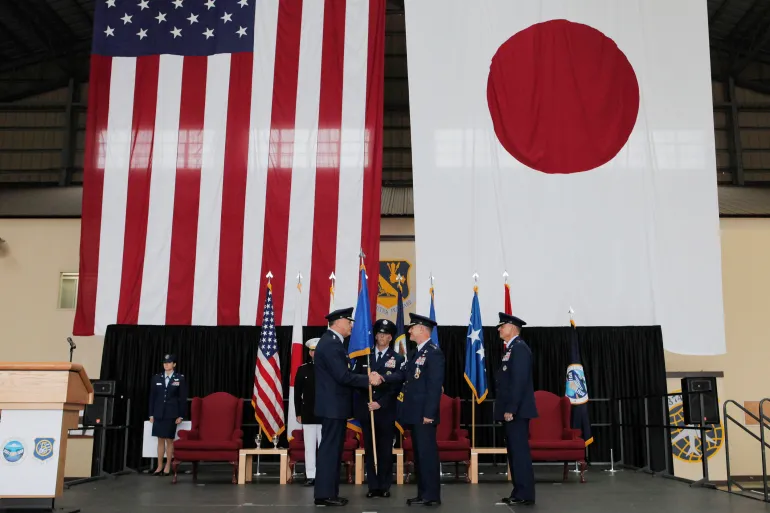
China and Russia Blast U.S. Typhon Missile Deployment in Japan: Why Americans Should Be Alert
The United States is pressing forward with a critical step in strengthening deterrence in the Indo-Pacific: the deployment of its Typhon intermediate-range missile system to Japan for joint military exercises. While this move represents a key advancement for regional security, it has drawn fierce condemnation from both Moscow and Beijing, who accuse Washington of destabilizing Asia.
Behind the rhetoric, however, lies a deeper truth: China views every U.S. military move in Asia as a threat precisely because it challenges Beijing’s long-term goal of dominating the region and pushing America out. For American readers, the lesson is clear: China’s growing hostility is not just Tokyo’s problem—it is America’s problem, and it demands vigilance.
The Typhon Mid-Range Capability system is a U.S. ground-based missile launcher capable of firing Tomahawk cruise missiles and SM-6 interceptors, giving Washington and its allies a flexible tool for both offense and defense. With a range of roughly 480 kilometers (300 miles), the system can target enemy ships, bases, and missile batteries across vast distances.
In an era defined by China’s massive naval expansion and missile buildup, Typhon represents an essential counterweight. The system was first deployed to the Philippines in 2024 during training exercises—a move that sparked Beijing’s anger. Now, its presence in Japan signals a broader American strategy: building a network of forward-deployed missile forces to contain China’s aggression across the East China Sea, South China Sea, and Taiwan Strait.
Predictably, both Moscow and Beijing wasted no time issuing warnings.
This playbook is familiar: paint America as the aggressor, cast U.S. allies as puppets, and portray China and Russia as defenders of “stability.” But Americans must recognize the reality: the only reason Beijing feels destabilized is because U.S. deployments make it harder for China to bully neighbors unchecked.
China’s reaction is not about peace—it is about power. The Typhon system directly threatens Beijing’s ability to operate freely in contested waters.
In other words, Typhon makes China’s military adventurism far riskier. That is why Beijing is desperate to brand the deployment as destabilizing when, in fact, it enhances deterrence and regional stability.
To understand the significance, it’s worth remembering how much the Indo-Pacific balance has shifted in a decade.
The Typhon deployment is not just a technical military move—it is part of a larger geopolitical reality where nations are rallying around the U.S. for protection against China.
Japan’s decision to host Typhon batteries, even temporarily at Iwakuni, shows how far Tokyo has moved in aligning with U.S. strategy. For decades, Japan relied primarily on defensive postures, constrained by its pacifist constitution. But China’s encroachment in the East China Sea, including near the Senkaku Islands, has changed Japanese public opinion.
By agreeing to field U.S. missile systems, Japan is signaling that it will no longer allow Beijing to intimidate it into passivity. For Washington, this strengthens the forward defense architecture needed to deter both China and North Korea.
This is not just a Japan-China issue. It is a direct challenge to U.S. national security:
The current situation carries echoes of the 1962 Cuban Missile Crisis. Then, Americans rightly saw the Soviet deployment of missiles in Cuba as unacceptable. Today, the mirror image is true: China views U.S. missile deployments in Asia as intolerable precisely because they prevent Beijing from coercing neighbors.
The difference is crucial: the U.S. is not using these systems to expand empire, but to defend freedom of navigation and alliance commitments. Americans must see through China’s propaganda that tries to equate deterrence with provocation.
China and Russia’s outrage over Typhon’s deployment to Japan is proof that Washington’s strategy is working. The more Beijing complains, the more it reveals how vulnerable its ambitions are to U.S. and allied deterrence.
For Americans, the key takeaway is this: every U.S. missile deployed in Asia is a shield not just for allies, but for America itself. If China is allowed to dominate the region unchecked, the consequences will reach U.S. shores in the form of economic coercion, military threats, and strategic blackmail.
The deployment of Typhon is not a provocation. It is a necessary reminder that in the face of authoritarian powers, deterrence is peace.